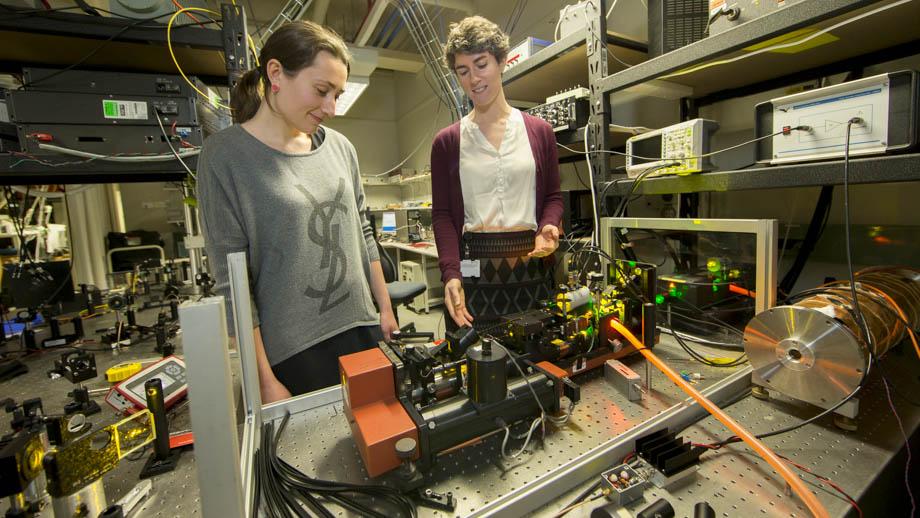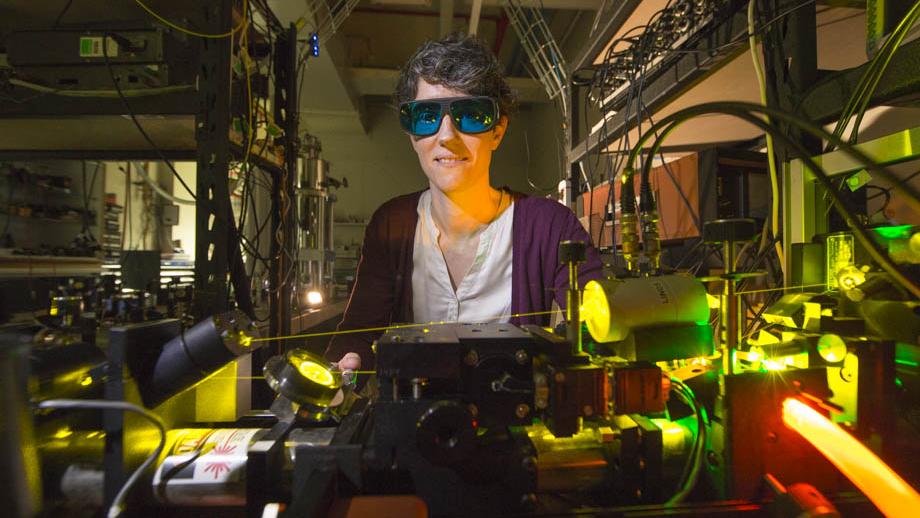The next leap forward
ACT Scientist of the Year Dr Rose Ahlefeldt, B Phil (Hons) ’08, PhD ’13, is working with crystals that may one day be used to store quantum information in the next generation of computers. Will Wright reports.
Quantum computers are anticipated to be the next big leap in computing technology and they will solve certain problems much faster than today’s machines.
We showed, for the first time, that it would be possible to make a quantum hard drive.
Researchers around the world are racing to build large-scale quantum computers, which promise a new era of secure networks, enhanced artificial intelligence and new tools to solve currently intractable computing problems.
Ahlefeldt, a Research Fellow at the ANU Research School of Physics and Engineering, is one of many researchers working to build this technology. She is part of a team that specialises in making memories suitable for storing the quantum information in these new-age computers.
She says the incredible fragility of quantum information, which normally causes it to degrade in a fraction of a second, poses a major challenge to researchers building quantum computers.
“To make large, networked quantum computers, we need something else – a quantum memory – to store the information from the computer for a long time,” she says. “Memories are also needed for quantum networks and eventually the quantum Internet.”
Ahlefeldt uses crystals that contain rare earth ions to store the quantum information, which starts off as pulses of light.
“I grow most of the crystals I work with, and it is a really simple process for a material that can do something as amazing as store quantum information,” she says.
“I grow the crystals from a water solution, on a piece of string, just like you might have done in school.”
Information is transferred from the light into the atoms in the crystal, thereby creating a quantum memory. Ahlefeldt is trying to understand how the atoms in the crystals interact with the light so she can choose the right materials to make quantum memories.
Focusing on the materials has proven a fruitful strategy for ANU quantum memory researchers over the past decade. Three years ago, Ahlefeldt was part of a research team that developed a crystal with a quantum storage time of six hours – still a world record today.
“We showed, for the first time, that it would be possible to make a quantum hard drive,” she says.
 Dr Rose Ahlefeldt (right) in her lab at the ANU Research School of Physics and Engineering. Photo by Lannon Harley.
Dr Rose Ahlefeldt (right) in her lab at the ANU Research School of Physics and Engineering. Photo by Lannon Harley.
Last year the team also developed a crystal with a long storage time at the transmission wavelength of optical fibre, which forms the communication backbone of today’s Internet. This breakthrough means a global-scale quantum communication network should be possible soon.
Ahlefeldt is now focusing on a key outstanding problem: creating quantum memories that can store a lot of information at once.
“Currently, we can only store around five bits, which are pieces of information, at the same time, and to have a reasonable network speed we’d like to store at least one million bits. Clearly, there is a long way to go,” she says.
The crux of the problem is that scientists have always chosen materials for quantum memories that have very low concentrations of rare earth ions so that those ions are far apart and do not interact, because that could degrade the quantum information.
However, that choice limits the storage density. Ahlefeldt is taking a different approach to the rest of the field by investigating materials that are highly concentrated in rare earth ions.
“Rather than trying to avoid interactions between rare earth ions, I’m studying the interactions that are present to work out how they will affect quantum storage,” she says.
“I’ll use this information to identify materials with controllable interactions that I can use to build quantum memories with higher data storage densities than we can currently make.”
For Ahlefeldt, the exciting thing about her research field is the opportunity to study fundamental science at the same time as building new technology.
“Meeting the requirements of quantum devices is so challenging we are pushing materials into regimes we’ve never accessed before,” she says.
“So we are learning all sorts of new physics about how matter behaves at the quantum level. It’s those discoveries that keep me coming in every day.”

